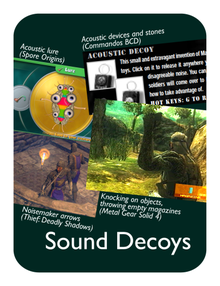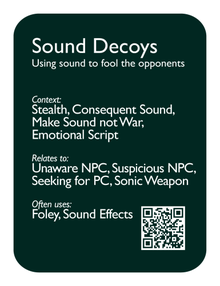Difference between revisions of "Random Card"
ValterAlves (Talk | contribs) m |
ValterAlves (Talk | contribs) m |
||
| Line 1: | Line 1: | ||
| − | |||
__NOCACHE__ | __NOCACHE__ | ||
<css>.firstHeading {display:none;}</css><css>.contentSub {display:none;}</css><css>.thumbinner {margin-top:16px;margin-bottom:50px;border:5px solid blue;}</css> | <css>.firstHeading {display:none;}</css><css>.contentSub {display:none;}</css><css>.thumbinner {margin-top:16px;margin-bottom:50px;border:5px solid blue;}</css> | ||
Revision as of 14:18, 6 October 2011
Random Card
Refresh this page or choose 'Random Card' (here or in the left sidebar) for another random card.
Sound Decoys

|

| |
| The card's front face | The card's back face |
Synopsis
| Using sound to fool the opponents. |
Relationships
Context:
Stealth ![]() , Consequent Sound
, Consequent Sound ![]() , Make Sound not War
, Make Sound not War ![]() , Emotional Script
, Emotional Script ![]() .
.
Relates to:
Unaware NPC ![]() , Suspicious NPC
, Suspicious NPC ![]() , Seeking for PC
, Seeking for PC ![]() , Sonic Weapon
, Sonic Weapon ![]() .
.
Often uses:
Foley ![]() , Sound Effects
, Sound Effects ![]() .
.
Description
A customary component of the gameplay is to deal with enemies along the game space. In some situations it is convenient to divert enemies’ attention and possibly to influence them to change their positions, either to be able to deal with one at time or to avoid confrontation at all.
Diverse forms of Sound Decoys can be included in the gameplay. Sound is particularly suitable for integrating meaningful decoy actions since it allows launching the decoy while avoiding visual contact. Spaces with reduced visibility also bring advantages both for the plausibility and of the usefulness of the decoy.
Examples
  Papa Sangre: In this particular level, noisy chicken may be released to divert the opponents from the PC's position and Footstep sounds. In other levels the PC's own Footsteps can be used to lure an opponent away from a position that needs to be visited (as the Helper Voice suggests).
|
External Resources
References to Tom Clancy's Splinter Cell "Distraction Camera": IGN Guides
Stevens, R., & Raybould, D. (2011, p. 125). The game audio tutorial a practical guide to creating and implementing sound and music for interactive games. Burlington, MA: Focal Press/Elesevier.






